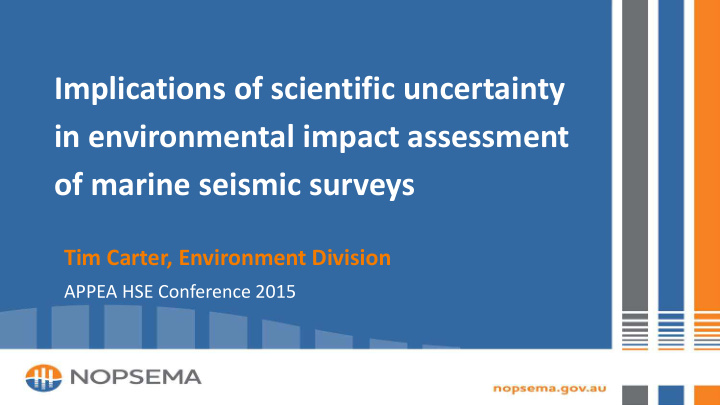



Implications of scientific uncertainty in environmental impact assessment of marine seismic surveys Tim Carter, Environment Division APPEA HSE Conference 2015
The issue • Not providing a full account/analysis of impacts • Uncertainty not acknowledged or addressed • Results in: – precautionary decision making – protracted assessment timeframes. 2
Why the focus on seismic? • Scientific uncertainty particularly high for underwater noise impacts – complex and paucity of data, not acknowledged • Less developed in approach to evaluating impacts and addressing uncertainty • Titleholders case for acceptable impacts and risks is weakened. 3
Background • Increase in number of speculative, strategic seismic surveys • A number of these proposed in particularly sensitive areas for whales and interacting with less studied, sensitive receptors • Heightened stakeholder concern, expectation for information • In response – a number of literature reviews underway on environmental effects of underwater noise. 4
Sources of uncertainty Insufficient baseline environmental data • • Predictions of sound attenuation poorly Describe environment supported and activity • Limited reference to data on ecological effects Impacts Effectiveness of controls • and risks • Limited monitoring of ongoing performance Implementation strategy 5
Implications of uncertainty Describe Predictions of impact environment Titleholder and activity Demonstrate acceptability Impacts and risks Evaluate evidence supporting predictions Regulator Reasonably satisfied decision Implementation strategy 6
Broader implications of uncertainty • The Regulator: – precautionary decision making • Titleholders: – protracted assessment timeframes – additional controls or conservatism in controls – may limit data coverage (excising sensitive survey areas and/or timeframes) – additional time/costs • Stakeholders: – reduced confidence in industry. 7
Options to reduce uncertainty Description of Sound exposure Ecological effects Effectiveness of controls environment predictions increase in review of site specific predictions increase in interrogation ensure controls are truly existing data of existing data adaptive increase in access/use horizontal and vertical use of surrogates where international reviews of MMO data supported consult data custodians reconciling units seek expert peer measures to test review/advice effectiveness strategic baseline validate received sound strategic research to field validation studies levels build knowledge base 8
Theoretical scenarios Scenario 1 9
Addressing uncertainty: Scenario 1 • Bathymetry Describe • Benthic habitats environment • Fish assemblages • Exposure level below array Characterise sound • Units exposure • Cumulative exposure • Peer reviewed literature Evaluate impacts • Unit consistency and risks • Advice from SMEs • Measures to Implementation strategy ensure 10
Addressing uncertainty: Scenario 2 • Best available data on whale Describe environment habitats Characterise • Site and airgun specific sound sound predictions exposure Evaluate • Ensure controls truly impacts adaptive and risks • Sound Implementation exposure strategy validation 11
Take home messages • Much more can be done to reduce scientific uncertainty: – better use of available data, i.e. scientifically robust evidence base to support predictions – develop specific measures to validate predictions – collaborative efforts to fill critical knowledge gaps. • Why?: – greater certainty and efficiency in approvals process – improved stakeholder confidence. 12
Thank you
Recommend
More recommend